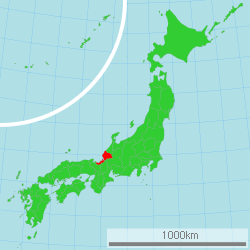Fukui Prefecture
福井県 | |
|---|---|
| Japanese transcription(s) | |
| • Japanese | 福井県 |
| • Rōmaji | Fukui-ken |
 Panoramic view of the Fukui plain, Fukui prefecture from the top of Monju | |
| Anthem: Fukui kenminka | |
 | |
| Country | |
| Region | Chūbu (Hokuriku) |
| Island | Honshū |
| Capital | Fukui |
| Subdivisions | Districts: 7, Municipalities: 17 |
| Government | |
| • Governor | Tatsuji Sugimoto |
| Area | |
| • Total | 4,190.49 km2 (1,617.96 sq mi) |
| • Rank | 34th |
| Population (June 1, 2017) | |
| • Total | 778,943 |
| • Rank | 43rd |
| • Density | 185.95/km2 (481.6/sq mi) |
| GDP | |
| • Total | JP¥3,695 billion US$33.9 billion (2019) |
| ISO 3166 code | JP-18 |
| Website | www.pref.fukui.jp/english/ |
| Symbols of Japan | |
| Bird | Dusky thrush (Turdus naumanni) |
| Flower | Narcissus (Narcissus tazetta) |
| Tree | Pine tree (Pinus) |
Fukui Prefecture (福井県, Fukui-ken) is a prefecture of Japan located in the Chūbu region of Honshū.[2] Fukui Prefecture has a population of 778,943 (1 June 2017) and has a geographic area of 4,190 km2 (1,617 sq mi). Fukui Prefecture borders Ishikawa Prefecture to the north, Gifu Prefecture to the east, Shiga Prefecture to the south, and Kyoto Prefecture to the southwest.
Fukui is the capital and largest city of Fukui Prefecture, with other major cities including Sakai, Echizen, and Sabae.[3] Fukui Prefecture is located on the Sea of Japan coast and is part of the historic Hokuriku region of Japan. The Matsudaira clan, a powerful samurai clan during the Edo period that became a component of the Japanese nobility after the Meiji Restoration, was headquartered at Fukui Castle on the site of the modern prefectural offices. Fukui Prefecture is home to the Kitadani Formation, the Ichijōdani Asakura Family Historic Ruins, and the Tōjinbō cliff range.
- ^ "2020年度国民経済計算(2015年基準・2008SNA) : 経済社会総合研究所 - 内閣府". 内閣府ホームページ (in Japanese). Retrieved 2023-05-18.
- ^ Nussbaum, Louis-Frédéric. (2005). "Fukui-ken" in Japan Encyclopedia, p. 217, p. 217, at Google Books; "Chūbu" Japan Encyclopedia, p. 126, p. 126, at Google Books.
- ^ Nussbaum, "Fukui" in Japan Encyclopedia, p. 217, p. 217, at Google Books.

